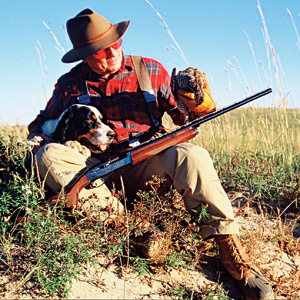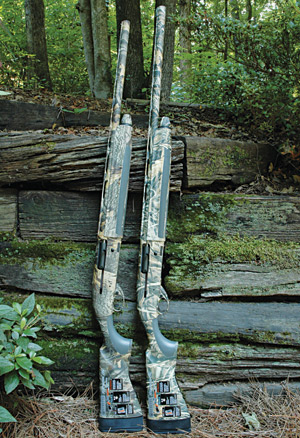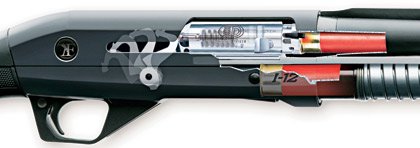Highlighting semi-autos, both new and old.
By Layne Simpson
 Choose an autoloader because you can shoot it well and not because it has greater firepower than a double. |
The first truly successful semiautomatic shotgun was designed by John Browning. His recoil-operated gun was first manufactured by the Belgium firm of Fabrique Nationale in 1903 and sold in America as the Browning Auto-5. In 1905 Remington Arms Company purchased the United States manufacturing rights for the design from Browning and introduced it as the Model 11.
Those two shotguns became so successful, they virtually owned the autoloading shotgun market during the entire first half of the 20th century. More than 850,000 Model 11 shotguns had been built by 1948, the year Remington dropped it from production. When production of the Browning Auto-5 ceased in 1998, almost three million had been produced by its Belgium and Japanese makers.
The old hump-backed Browning is an excellent shotgun and many are still in use today, but like most machines, it is far from perfect. Its biggest shortcoming is the inability to handle a variety of loads without mechanical adjustment on the part of the shooter. Switching from light to heavy loads (and vice versa) requires removal of the forearm and changing the position of a brass friction ring on the magazine tube. Also, the 23„4 inch gun will not handle three-inch shells while the three-inch gun usually refuses to function with some 23„4 inch ammunition.
The first successful gas-operated shotgun was introduced, not by Browning, Winchester or Remington as one might logically expect, but by the mail-order firm of Sears Roebuck. Marketed under the highly successful J.C. Higgins brand name, it was introduced in 1956 and called the Model 56. An older kid who lived just up the road from our little farm owned the first one I ever saw and while it seemed to work fine, its bulky gas-handling system required an extremely fat forearm and that made the gun ungainly and poorly balanced. The author of the first test report I read on the gun described it as being slightly pregnant.
Remington introduced its first gas gun, the Sportsman-58, only a few months after the J.C. Higgins Model 56 came along and while it was a bit more streamlined than the Model 56, it would not handle all 23„4 inch loads interchangeably. Rather, its magazine cap had to be twisted to the "H" position when heavy loads were used and then set on the "L" position for light loads. While that procedure was quicker and more convenient than changing the friction ring on the Browning Auto-5, it still fell short of perfection in autoloader design.
The next step toward ideal took place for Remington in 1959 with the introduction of the Model 878 Automaster. While the 878 was capable of shooting all 23„4 inch loads without mechanical adjustment, it proved to be nothing more than a sign of better things to come. In 1963, Remington introduced the Model 1100 and it went on to become the best-selling autoloader of all time. The Browning Auto-5 and Remington Model 11 may have ruled the roost during the first half of the 20th century, but the second half absolutely belonged to the Model 1100.
 Gas guns like these two Beretta A391 Xtremas make the 12 gauge, 31„2 inch shell tolerable to shoot. |
By 1983 over three million had been manufactured and the total number is surely climbing toward five million as I write this. The Model 1100 is the only semiautomatic shotgun to be built in all five of the popular chambers: 28, 20, 16 and 12 gauges and .410 caliber. Still, in the minds of some hunters the Model 1100 falls a tiny bit short of perfection simply because it is incapable of handling 23„4 inch and three inch shells interchangeably.
The first autoloading shotgun capable of handling both shell lengths was the Smith & Wesson Super 12, or Model 1200 as it would later be called. While the Model 1200 was in production for only a few years, it stayed around long enough to inspire other manufacturers to develop shotguns capable of the same level of versatility. The 1980s brought us an updated version of the Remington Model 1100 called the Model 11-87 as well as others such as the Browning B80, Weatherby Eighty-Two, Beretta 303 and Mossberg Model 1000. Like the Smith & Wesson gun, all would shoot 23„4 and three inch shells.
That was about it until the mandatory use of steel shot called for a shotshell capable of handling a heavier payload than the three-inch 12 gauge. The 10 gauge shell fit the bill nicely and despite the fact that a Remington SP10 chambered for it is still my all-time favorite duck and goose gun, many waterfowlers consider it a bit on the heavy side. And so it came to pass that the 31„2 inch 12 gauge shell was developed and the Italian firm of Benelli beat all competition to the punch in offering an autoloading shotgun chambered for it. But it didn't take Remington, Beretta, Winchester, Browning and other companies long to catch up and we now have numerous autoloaders chambered for the extra-long 12 gauge shell.
The biggest advantage the autoloader has over other types of shotguns is its ability to make recoil seem lighter than it actually is. When everything including gun weight and the load being used are the same, actual recoil is the same regardless of the type of shotgun being fired but recoil as perceived by the shooter is less with the autoloader because of its ability to prolong the recoil curve.
I will never forget the first time I fired the then-new 31„2 inch 12 gauge shell in a pump gun. By the time the stars went away I had decided that if I could not get a particular job done with the 23„4 or three inch shell, I would leave it for someone else to do. Then came an opportunity to hunt with a Browning Gold autoloader chambered for the 31„2 inch shell. After shooting about a dozen rounds of heavy 21„2 ounce loads at the pattern board, I headed to the woods and bumped off two turkey gobblers.
A good gas-powered autoloader is capable of reducing recoil to the point where I no longer have any qualms about shooting our longest 12-gauge shell. I now use a Remington Model 11-87 and various 31„2 inch loads for some of my waterfowl hunting and seldom do I notice its recoil.
 When properly maintained, a good autoloader will funtion with 100 percent reliability. |
Its ability to soften the blow out back makes the autoloader an excellent choice for someone who is sensitive to recoil. Sometime back my wife Phyllis became interested in shooting sporting clays but informed me that her lightweight 16 gauge double was too much gun for a game that can use up several boxes of shells in a day of shooting. After trying a variety of other guns, she settled on a 28 gauge Remington Model 1100. It has since become her favorite in the dove field as well. Of course, the fact that the little Model 1100 wears absolutely gorgeous wood from the Remington custom shop had no influence on her choice.
As a rule, autoloaders are heavier than pump guns and this can be either good or bad. At 71„2 pounds, the 28 gauge Model 1100 that once belonged to me weighs about half a pound more than a Remington 870 of the same gauge and the extra heft is why Phyllis finds it so comfortable to shoot. And yet it is not too heavy to carry for long days in the field. For those who prefer lighter guns, the Franchi 48AL in 20 or 28 gauge weighs around 51„2 pounds while the Benelli Montefeltro and Beretta AL391, both in 20 gauge, weigh only an ounce or two over six pounds.
I am sure many hunters buy the autoloader because of its ability to fill the air with lots of shot but I have not found that to be an advantage. If having a third shot on tap gives the hunter who uses an autoloader an edge over his pal who shoots a double, you cannot prove it by me. A friend and I hunt quail a lot together and our proficiency with the shotgun is about the same. When he hunts with an autoloader and I hunt with a double we almost always kill about the same number of birds. When he hunts with a double and I hunt with an autoloader the score still reads about the same. Gun balance and fit along with the ability to shoot a shotgun are far more important than firepower.
When maintained properly and fed good ammunition, I find the autoloader to be about as reliable as any other type of shotgun. But it will not tolerate a lot of neglect and abuse. I have seen pump guns dropped in the water, stepped on with muddy boots, sat on by wet dogs, used as emergency boat paddles and hauled for an entire season beneath a pile of ducks in the bottom of a boat and they never failed to feed or fire when called on by their owners. Mistreat an autoloader in the same manner and you will probably find yourself hunting with a single-shot, if it will fire at all.
There is one thing I miss about the grand old Browning Auto-5. Its magazine cutoff was so quick, easy and fumble-free, I could switch out the duck load in its chamber for a goose load in no time flat. The only autoloaders I shoot today with that feature are a pair of Franchi 48Als in 20 and 28 gauge. I can switch those guns from their quail mode to their pheasant mode quicker than you can say John Browning.






